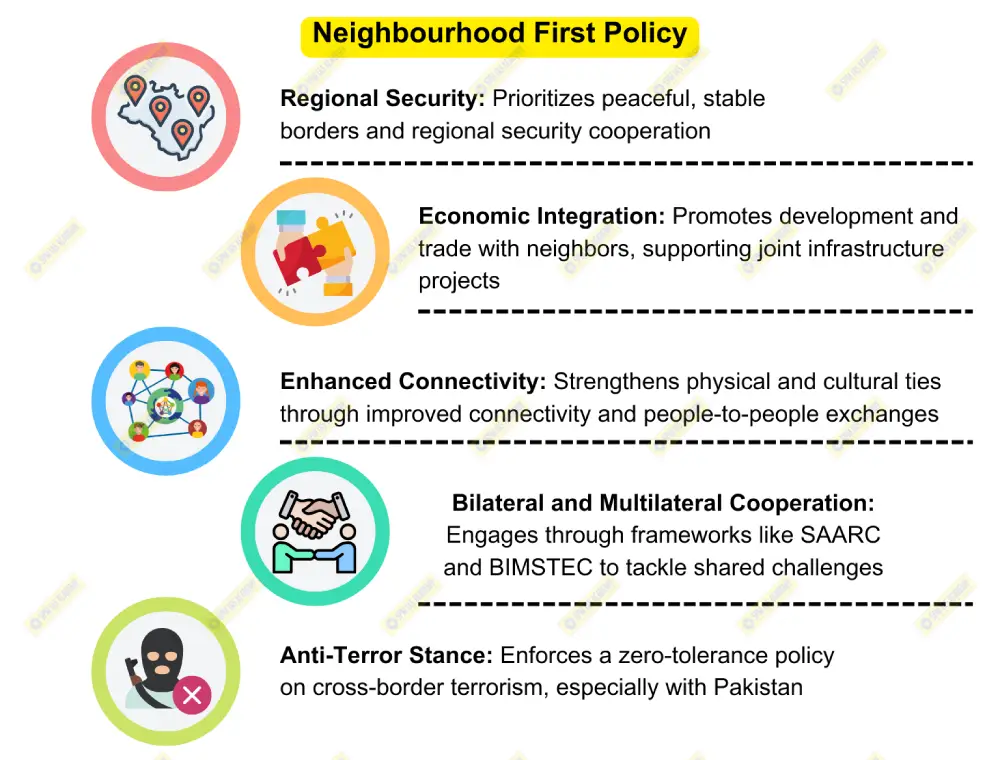India’s “Neighbourhood First Policy” reflects a diplomatic commitment to strengthening ties with its immediate neighbours, fostering regional stability, economic cooperation, and shared security. However, India’s relationship with Pakistan is complex, marked by historical disputes, particularly over Kashmir, periodic cross-border tensions, and issues related to terrorism. Despite these challenges, India’s stated objective has consistently been to achieve peaceful and constructive relations with Pakistan in alignment with its broader regional strategy.

India’s Neighbourhood First Policy and its Stance on Pakistan
The “Neighbourhood First Policy” seeks to prioritize regional cooperation and peace within South Asia, as outlined by India’s strategic objectives in promoting stability and prosperity across the subcontinent. With Pakistan, India envisions a relationship based on the principles of sovereignty, mutual respect, and peaceful coexistence. Prime Minister Narendra Modi has reiterated that “dialogue is the only way to resolve the issues,” emphasizing a commitment to diplomatic solutions over conflict.
Key Issues in India-Pakistan Relations
- Cross-Border Terrorism: A major impediment to normalizing relations is Pakistan’s alleged support for cross-border terrorism. The 2008 Mumbai attacks, the 2016 Uri attack, and the 2019 Pulwama attack have strained relations. India has maintained that meaningful dialogue can proceed only when Pakistan takes credible action against terrorist organizations operating on its soil, in line with UNSC resolutions and international norms.
- Kashmir Conflict: The Kashmir dispute remains a focal point of tension. India views Kashmir as an integral part of its sovereign territory, while Pakistan advocates for international intervention, which India considers a violation of the Shimla Agreement’s principle of bilateral resolution. India’s revocation of Jammu and Kashmir’s special status in 2019 was seen as an internal matter but led to a fresh escalation in rhetoric and responses from Pakistan.
- Ceasefire Violations and Border Tensions: Frequent ceasefire violations along the Line of Control (LoC) exacerbate mutual distrust. Both sides have intermittently adhered to ceasefire agreements, most notably in February 2021, when both nations reaffirmed the 2003 ceasefire agreement, leading to a temporary reduction in hostilities.
- Economic and People-to-People Engagement: Economic integration remains underutilized due to political friction. Trade and people-to-people exchanges are sporadic, despite their potential to build mutual understanding. Regional initiatives like the South Asian Association for Regional Cooperation (SAARC) and the TAPI (Turkmenistan-Afghanistan-Pakistan-India) pipeline project remain largely unfulfilled due to India-Pakistan discord.
Diplomatic Pathways and International Responses
India’s stance is to engage in “constructive dialogue” contingent on Pakistan addressing terrorism. As former Indian Prime Minister Atal Bihari Vajpayee remarked, “You can change friends, not neighbours.” India’s engagement approach reflects this pragmatism by seeking peace while remaining prepared for defense.
The global community largely supports India’s demand for a terrorism-free environment for peace. The Financial Action Task Force (FATF) placed Pakistan on its “grey list” for its inadequate measures against terror financing, which reinforced India’s concerns about Pakistan’s accountability in counter-terrorism.
Path Forward: Opportunities and Challenges
- Confidence-Building Measures (CBMs): India has periodically advocated for CBMs, like the Kartarpur Corridor for Sikh pilgrims, demonstrating that even amidst high tensions, limited cooperation is feasible. Expanding such initiatives could help ease tensions and foster goodwill.
- Third-Party Mediation: Although India traditionally rejects third-party mediation in alignment with the Shimla Agreement, some international actors, like the United Nations and the United States, have expressed willingness to support dialogue. India, however, insists that resolution must be bilateral.
- Multilateral Cooperation: Both countries participate in forums like the Shanghai Cooperation Organisation (SCO), which provide a platform for dialogue on security and regional cooperation. While these platforms cannot directly resolve bilateral issues, they enable dialogue on shared regional challenges.
Conclusion
India’s “Neighbourhood First Policy” aims for peaceful and cooperative ties with all neighbors, including Pakistan, but remains grounded in the principle of “zero tolerance for terrorism.” For sustainable peace, Pakistan must address India’s core concerns about cross-border terrorism, as reiterated by Prime Minister Modi’s call for “a terrorism-free environment.” The path forward lies in balancing security imperatives with incremental trust-building measures that can pave the way for stable, constructive relations.












